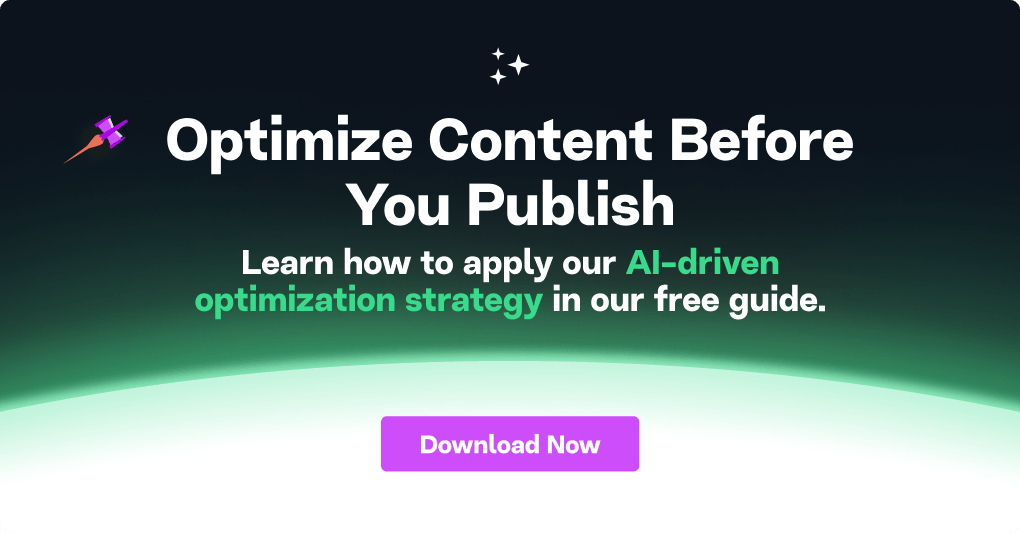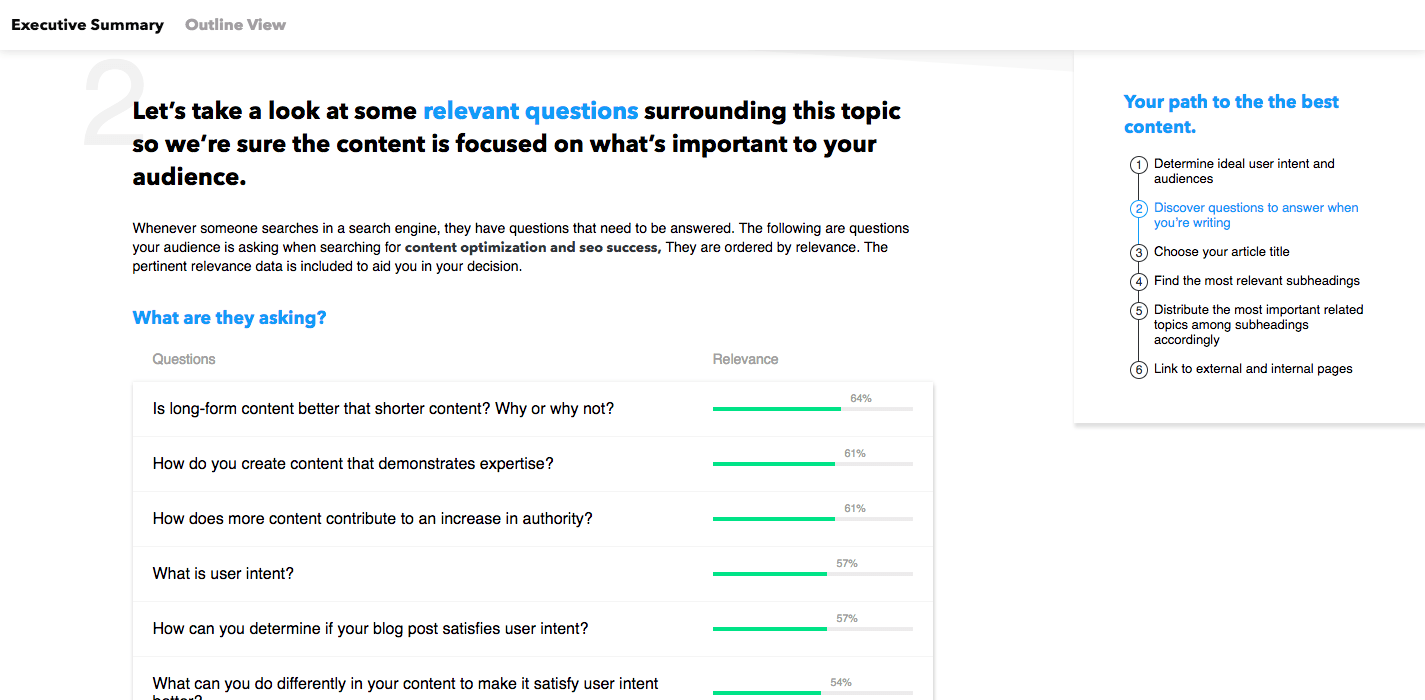How to Optimize Existing Content to Get more Traffic
Content marketing is overwhelmingly focused on publishing new content. Yet there is so much value to be gained ensuring existing content is optimized and kept updated.
Content optimization entails refreshing old content by expanding its topical comprehensiveness and relevancy such that its information remains current and matches a search engine’s subject-matter matrix.
Key Factors in Content Optimization
Two key factors in successfully optimizing content are the marriage of high editorial standards and best practices in SEO.
Your content needs to serve the explicit purpose of a given semantic search. It must meet ‘user intent’ to be useful, engaging and interesting to your audience while also implementing carefully vetted information on a subject matter area (some of which we like to call ‘related topics’).
Optimization of existing content is required on a routine basis to capture and maintain dominant position on any SERP that will matter to your company and your intended target audience.
Best practices in organic search are changing due to software innovations and Google’s user-orientation. Social media and AdWords are diminishing in effectiveness, whereas the publication of high-quality content has far more impact.
Part of the reason is that content that drives traffic through organic search represent genuine searcher interest. Ads are frequently ignored. Even though they’re visible (because they were paid for), they don’t always meet the criteria of search intent.

The Role of Content Inventory and Optimization
First, let’s address the challenge of optimization from an inventory perspective. If you’re only interested in optimizing several articles, that is discussed in more detail in the sections below.
Optimization should start with a sound understanding of what you have in your current content inventory. That means:
- knowing how well it’s performing (in what subject matter areas)
- why it’s performing satisfactorily
- what aspects of your old content need updating
- what articles require additional subject matter
If you are struggling with an old content inventory system that gives you hardly any of this information, it may be time to reconsider your approach to content marketing.
Content Inventory and Optimization Software
Currently, there are zero solutions on the market (aside from MarketMuse Suite) that offer the ability:
- to analyze your full content inventory in a matter of days
- provide detailed and up-to-date feedback in real-time about content that needs updating
- precisely how to do it
In addition to software, there are a series of deliverables that offer guidelines for writing top-ranking articles. These include:
- machine language-generated questions
- linking suggestions
- a related topic matrix for comprehensive coverage
A goal of ours at MarketMuse is to provide effective and less frustrating content optimization workflows that streamline successful content generation.
Using a keyword based strategy for your site is not enough. Content creators need a current list of their inventory with a search console showing a competitive content score in a given subject matter area and revealing areas for improvement. This is only part of what we’ve developed for optimal performance in semantic search.
We’ve set up a page where you can try out the software if you want to upgrade your content strategy.
Five Content Optimization Tips
Let’s look at a few actionable solutions you can use on your own to make updates today. Keep in mind that there are many ways to do SEO. If you have other methods that are working for you, we’re happy that you’ve been successful. Here are a few ideas that could contribute as well.
Keep Content Fresh
Make sure that an article’s information is accurate and up-to-date. A blog loses organic traffic as fast as it loses credibility (keep in mind, this is different than being current).
Searchers are disappointed when they find ‘dated’ material on a website, so make sure to stay on top of the latest info in your area of expertise. This is critical if one of your editorial goals is to maintain your domain’s authority as a place of subject-matter expertise.
Keeping content current also helps earn legitimate inbound links from sites that genuinely want to link to you as a source of reliable information. It’s better to obtain inbound links by producing high-quality content than buying them from a shady practitioner. That practice can accrue a ranking penalty.
A steady cadence of refreshing blog posts is healthy for domain authority. Often, the first challenge is in choosing which content items to refresh.
When it comes to content optimization, your topical comprehensiveness should beat that of competitors on a given SERP. Content items that are ranking closely below competing articles in important areas are good candidates for optimization, as they are within reasonable ‘striking distance.’
Also, good candidates are articles that rank between the second and fourth position on the first page of the SERP. If they rank worse than that, you’ll probably want to consider writing an article from scratch rather than optimizing it.
You can take several steps when ‘refreshing’ an article to improve its ranking. Here, you’ll find some overlap between the ‘editorial side’ and SEO.
For articles that are meant to be current, you have three choices. You can either update it, remove irrelevant information or do both. Aside from legacy content that somehow ranks forever, old content can get deranked as interest in a subject matter area wanes over time.
Review Internal Links and Anchor Text
Interweaving your content with internal links helps improve the user experience. So if these are missing, they should be added.
In your linking for on-page SEO, use important search terms as anchor text for your internal links.
The user experience should be such that searchers quickly find that for which they are looking. This means catering to varied levels of interest. Blog articles targeting top-of-the-funnel organic search traffic may include links to other blog posts further down the funnel.
While it won’t necessarily raise your conversion rate, it could increase overall conversions. The user search process could start with the reading of a blog post that ends up in a purchase opportunity.
Focus on Topics Instead of Keywords
In this era of the semantic search engine, targeting long-tail keywords is an exercise in futility. The most important part of optimizing an article is to add to its topical comprehensiveness. Do this, and you’ll fly up in the rankings the next time it is indexed.
To optimize a post to rank better in a given subject matter area, you could go through all your old content items and see where they are ranking for the semantic searches a user might intuit.
In other words, what are users typing into a search engine that would lead them to informational content that is relevant to your company?
For instance, if you were trying to gain authority on the topics ‘iCloud photo library’ or ‘iCloud storage’ you could publish an article on ‘How to store photos online.’ A blog post on how iCloud storage solves your storage problems could also work as it would help move readers on a buyer’s journey towards iCloud photo library.
This is a fundamental approach to optimizing for a subject matter area. There are much more advanced forms of AI-fueled topic research.
Fill The Content Gaps
Throwing resources at optimizing articles won’t help you succeed at search unless your process finds and fills any content gaps. These gaps are important related topics that your content doesn’t address. If your post suffers from many of these holes, then it’s ‘thin content,’ regardless of its length.
SEMrush, Screaming Frog and Ahrefs are all great tools to get more detailed information about your rankings. Unfortunately, they require significant amounts of manual work when trying to determine how to improve your blog posts.
You’ll have to analyze and recreate their data in your own image and find a way of effectively communicating it to your writers. That’s costly, tiresome and time-intensive.
Initially, you’ll be able to tell where your content is ranking on a SERP. But you’ll start to run into problems trying to figure out precisely why. Here, our solution would be to either use Optimizer or to get an Optimize Brief.

After an analysis of your website and any particular URLs, we can tell precisely what elements of its knowledge graph are missing. Add those to your article so that it dominates its respective subject matter area.
Focus on Addressing User Intent
Search engines give higher ranking to blog posts that provide readers that for which they are looking. So let’s take a step back and look at user intent, another essential part of the puzzle.
To succeed at content optimization, double-check to ensure you provide the answers a reader would want on that SERP as early-on as possible in the content. Make sure your article meets user intent right away. Rewrite the first few paragraphs if it doesn’t.
Meeting user intent means providing the answer your reader is seeking ASAP in an article; leaving aside the ‘right keywords.’ If you’re not quite sure what should be entailed in this, take a quick look at the top five ranked articles in the SERP you want to capture. See what they cover in the first few paragraphs.
Efficiently addressing user intent can significantly impact your click-through rate. Most editors are familiar with the featured snippet at the top of a SERP.
If you nail user intent, the featured snippet may use a quote from your article. Search engines reward you for capturing a concept accurately and with extraordinary concision.
For a non-ranked site, remember that videos and images aren’t going to help unless they hit some jackpot and become viral. Your best bet for improving your ranking will be to generate high-quality content.
Content Inventory Solutions
Currently, most content inventories are entirely disorganized. It’s one of the most significant problems people have in their approach to content marketing strategy. Students of SEO have struggled with this since the inception of the search industry.
Some companies have multiple systems for archiving their URLs and content items on a domain. It often takes ages to update inventories, and by the time they are updated, the inventories have often changed again.
Even at the end of an inventory update, content strategists are usually left with a giant document that gives little to no sense as to what the next editorial step should be when it comes to ‘search.’
The Next Step
The ideal solution to this challenge would be a software suite that imports and organizes a company’s inventory with detailed information about each URL when it comes to current search ranking for various subject matter areas as well as ranking opportunities and implementable solutions.
That’s just a part of what MarketMuse Suite does. Try it; you’ll like it!
Featured image vector designed by Freepik
What you should do now
When you’re ready… here are 3 ways we can help you publish better content, faster:
- Book time with MarketMuse Schedule a live demo with one of our strategists to see how MarketMuse can help your team reach their content goals.
- If you’d like to learn how to create better content faster, visit our blog. It’s full of resources to help scale content.
- If you know another marketer who’d enjoy reading this page, share it with them via email, LinkedIn, Twitter, or Facebook.